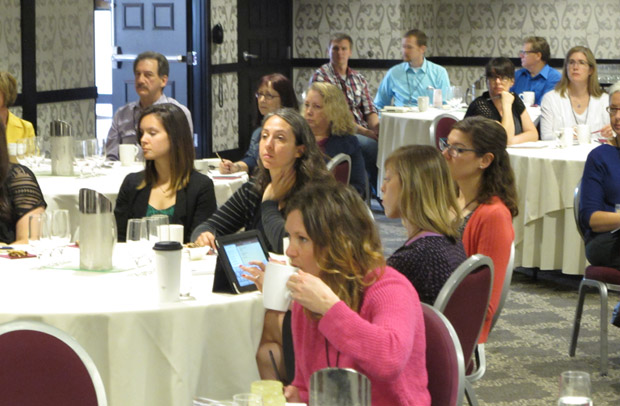 BY LINDA BAKER | EDITOR
BY LINDA BAKER | EDITOR
Reinventing capitalism. Office dumpster divers. Handprints versus carbon footprints.
BY LINDA BAKER | EDITOR

Reinventing capitalism. Office dumpster divers. Handprints versus carbon footprints.
These are some of the innovative ideas panelists and attendees discussed during the second annual Oregon Business “Green Your Workplace” seminar yesterday in the Nines Hotel. The two hour seminar generated a rich stream of strategies for businesses seeking to reduce environmental impacts in the workplace.
The recipe for success is “education, engagement and persistence,” said panelist Jordan Folks, a research scientist with Research Into Action, a survey and evaluation firm.
People who live in the Pacific Northwest view water as an abundant and renewable resource, said panelist Lisa Petterson of SERA Architects. That assumption is outdated given the drought conditions gripping the West Coast. “We need to redefine the way we think of water. Why are we wasting a precious resource to flush toilets?”
A green architecture firm, SERA functions as a test laboratory for environmentally friendly products and design strategies. For example, Petterson said each toilet stall at SERA Architects is outfitted with a different low flow model.
Rose City Mortgage owner Renee Spears put sustainability in context of individual happiness. “The key to employee engagement is meaning and purpose,” she said. “Our goal is making the world a better place and personal growth.”
Panelist Sarah Severn, a former Nike sustainability director, echoed that sentiment. People buy into sustainability initiatives “when you deeply engage with the heart as well as the mind.”
Severn said green leadership isn’t the sole purview of CEOs and that employees also have an important role to play in raising awareness and changing behaviors. Nevertheless, she called on executives to take a more aggressive political stance on climate change.
“We’ve known about the science for a long time but people are still waiting,” Severn said. “You wouldn’t wait until you had a 105 degree fever before going to the doctor.”

Jordan Folks described a Research In Action case study that involved substituting personal hand towels (common in Japan) for paper towels in the bathroom.
Anticipating employee push back around sanitation, the in-house “Green Team” touted the benefits — “no more rough paper on your hands” — and as a marketing strategy inscribed the towels with the Research in Action logo. Each member of the Green Team takes turns washing the towels at home.
How do you get employees and employers to support green workplace initiatives? “It’s all in the framing,” Folks said.
Panelists discussed the challenge of taking office sustainability practices to the next level. “We’ve greened a lot of what can be greened,” said Spears. “What does a green team 2.0 look like?” asked moderator Megan Shuler, coordinator of the city of Portland’s Sustainability at Work program.
Pettersen said SERA deploys green team members to sort through garbage and identify items that should go in the compost or recycling bins instead. One attendee suggested creating a “monster robot” from the misplaced items.
Another participant said her office had instituted a “handprint” policy: a positive spin on the carbon footprint concept. So employees might measure the emissions impact of air travel, but they also document their low impact behaviors. “Guilt is not a motivator,” she said.
Spears is taking a more radical approach to greening the workplace — and the planet. “We’re not growing our business,” she said.

 BY LINDA BAKER | EDITOR
BY LINDA BAKER | EDITOR

